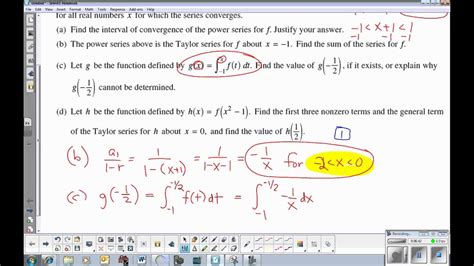In Calculus BC, Taylor series expansions are a crucial topic that students must master. The exam tests students’ understanding of these expansions in several ways, including:

1. Finding Taylor Expansions:
Students may be asked to find the Taylor series expansion of a given function centered at a specified point. This involves applying the Taylor series formula and differentiating the function multiple times to determine the coefficients.
2. Evaluating Taylor Approximations:
Students must be able to use Taylor approximations to evaluate the value of a function at a specific point. This involves choosing an appropriate number of terms in the expansion and evaluating the resulting polynomial.
3. Applying the Remainder Formula:
The remainder formula provides an estimate of the error in using a Taylor approximation. Students may be asked to use this formula to determine the accuracy of their approximations.
4. Convergence and Error Analysis:
Students must understand the conditions under which Taylor series converge. They may be asked to determine the radius of convergence and the interval of convergence for a given series.
When working with Taylor series, students commonly make certain mistakes, including:
- Incorrect calculation of derivatives
- Failing to apply the proper Taylor series formula
- Using too few terms in the expansion
- Misinterpreting the convergence and error analysis results
To successfully tackle Taylor series questions on the Calc BC exam, students should follow a systematic approach:
- Identify the function and center: Determine the function to be expanded and the point about which the expansion is centered.
- Apply the Taylor series formula: Use the appropriate formula for the Taylor series expansion of the function.
- Find the derivatives: Differentiate the function as many times as necessary to determine the coefficients of the expansion.
- Evaluate the expansion: Substitute the specified point into the expansion to obtain a polynomial approximation.
- Analyze convergence: If necessary, determine the radius and interval of convergence for the expansion.
1. How many terms should I use in a Taylor approximation?
The number of terms depends on the desired accuracy. More terms yield more accurate approximations.
2. What is the remainder formula used for?
The remainder formula provides an estimate of the error in using a Taylor approximation.
3. How do I determine the radius of convergence for a Taylor series?
The radius of convergence is given by the formula R = 1 / lim sup |a_n^(1/n)|.
4. What are some applications of Taylor series expansions?
Taylor series expansions are used in various fields, including:
* Approximating functions
* Solving differential equations
* Studying the behavior of functions near particular points
